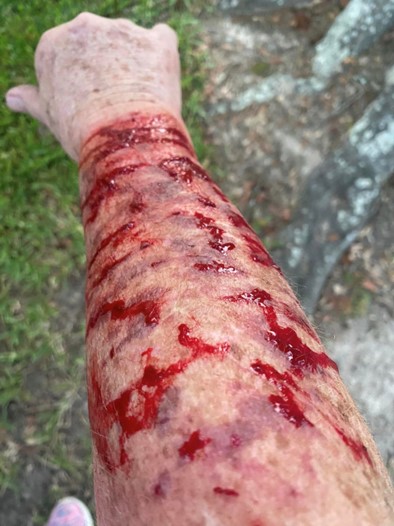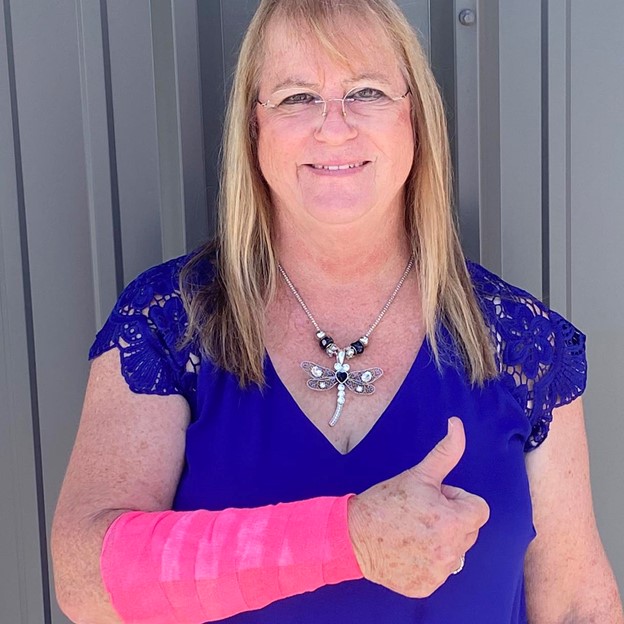Peggy Jones was mowing her lawn in Beaumont, Texas when “all of a sudden, out of the clear blue sky, a snake fell … and landed on my arm,” the 64-year-old told Alisha Ebrahimji of CNN. The snake wrapped itself around her right arm and it would not let go; the more she tried to rip the snake off her, the tighter its grip became. She feared the snake might bite her and inject her with venom – having already been bitten by a venomous snake in the past.
As if a snake falling from the sky and squeezing your arm is not bizarre enough, a brown and white hawk dove out of the sky and tried to reclaim the snake with wings flapping in her face and talons driving into her right forearm. She was still on the mower, weaving around her yard, in utter panic, with a ferocious fight for life occurring right on her arm. Jones told a journalist that it was “utter chaos…beyond anything I had ever experienced”.
Finally, the hawk was able to pull the snake away from her arm and fly away. Just like that, the chaos was over. However, her right arm was covered in blood, bruises, cuts, lacerations, and punctures. She knew to look for worsening swelling and discoloration that might indicate a life-threatening envenomation.

Photo from the social media of Wendell Jones
She was able to get her husband’s attention, who at first, did not understand what had happened to his wife, “It was probably three minutes before I actually understood what happened to her”. After he rushed her to the emergency department, Peggy received antibiotics and wound care.
Peggy described the snake as a 4.5 foot long, dark colored snake. This could meet the description of many local species including, but not limited, to Black Rat Snake, Black Racer, Western Cottonmouth, Gulf Swamp Snake, Mississippi Green Water Snake, Plain-Bellied Water Snake, Broad-Banded Water Snake, Graham's Crayfish Snake, Florida Redbelly Snake, or Texas Indigo Snake- some of which are venomous.
Texas is also home to a diverse range of hawk species that could have been the co-culprit. Some local hawk species include the Red-tailed, Swainson's, Ferruginous, Cooper's, Harris's, and Broad-winged hawks. These hawks occupy various habitats across the state, from open grasslands to woodlands and urban areas. Each species has its own unique characteristics and behaviors, contributing to the rich avian diversity in Texas.
Raptor attacks on humans in Texas are extremely rare occurrences. While the state is home to various raptor species, such as hawks, eagles, and owls, these birds typically pose little threat to humans. Raptors are focused on hunting and feeding on smaller animals and generally avoid interactions with people. The occasional reported incident usually involves a raptor feeling threatened or defending its nest, rather than a deliberate attack on humans. In most cases, maintaining a safe distance and respecting the birds' natural behaviors can help prevent any potential conflicts between humans and raptors. Unfortunately, a hawk dropping a snake onto someone is not something one can predict or even reliably avoid.
Evidence is limited, however, in general, raptor attack wounds should be addressed similar to other animal attack wounds with hemorrhage control and thorough cleaning to prevent infection. The incidence of associated infections is unclear. The incidence of hawk attacks on humans in the continental US is historically rare, however, hawk attacks have recently been reported to be on the rise in the Austin, Texas area. The Unalaska/Dutch Harbor, Alaska area alone can see over ten eagle-human attacks a year. This hawk was presumably only after the prey it had dropped; prey that happened to land directly on the right arm of Peggy Jones. As for the rest of us, keep one eye on the sky.

Photo from the social media of Peggy Jones